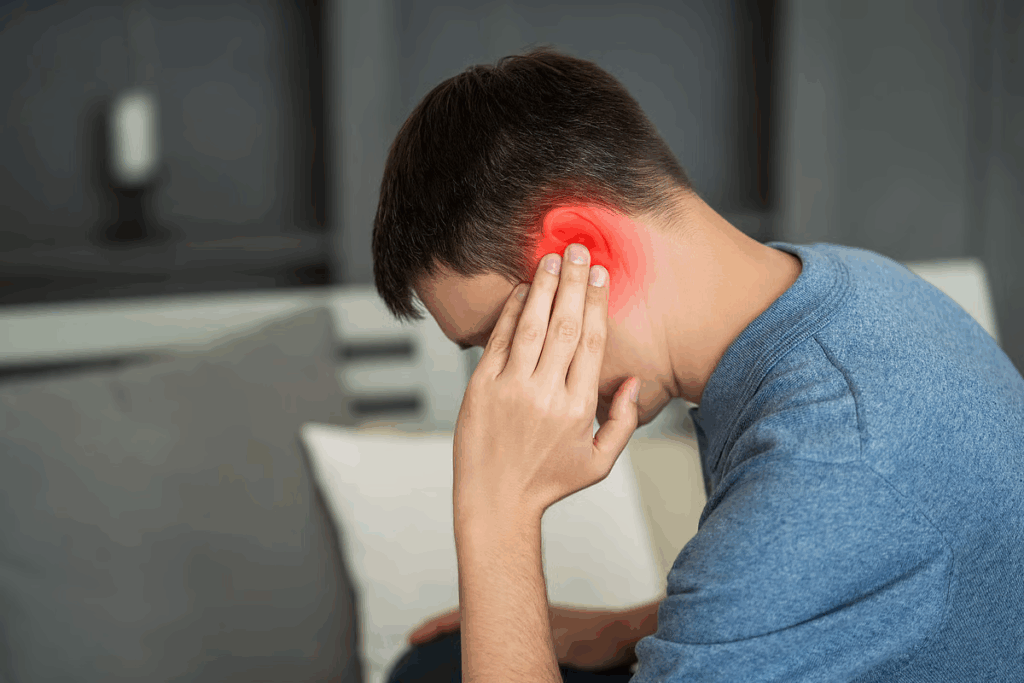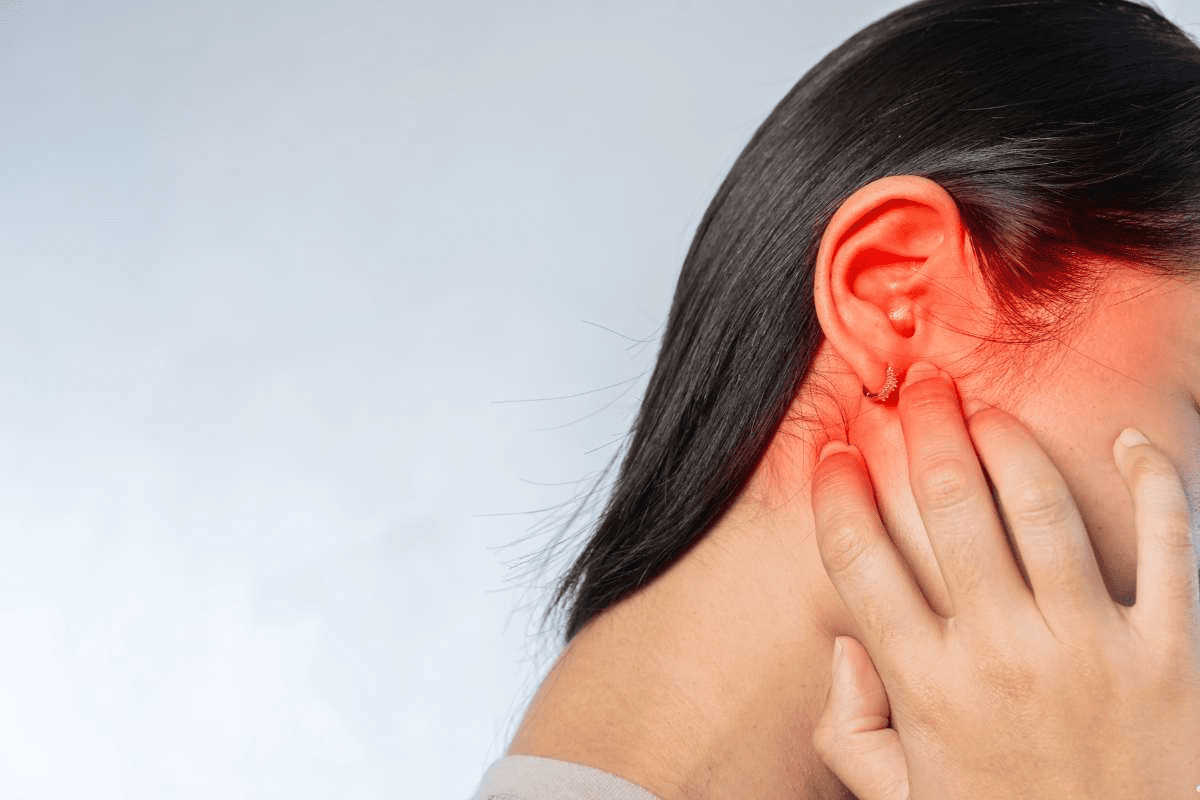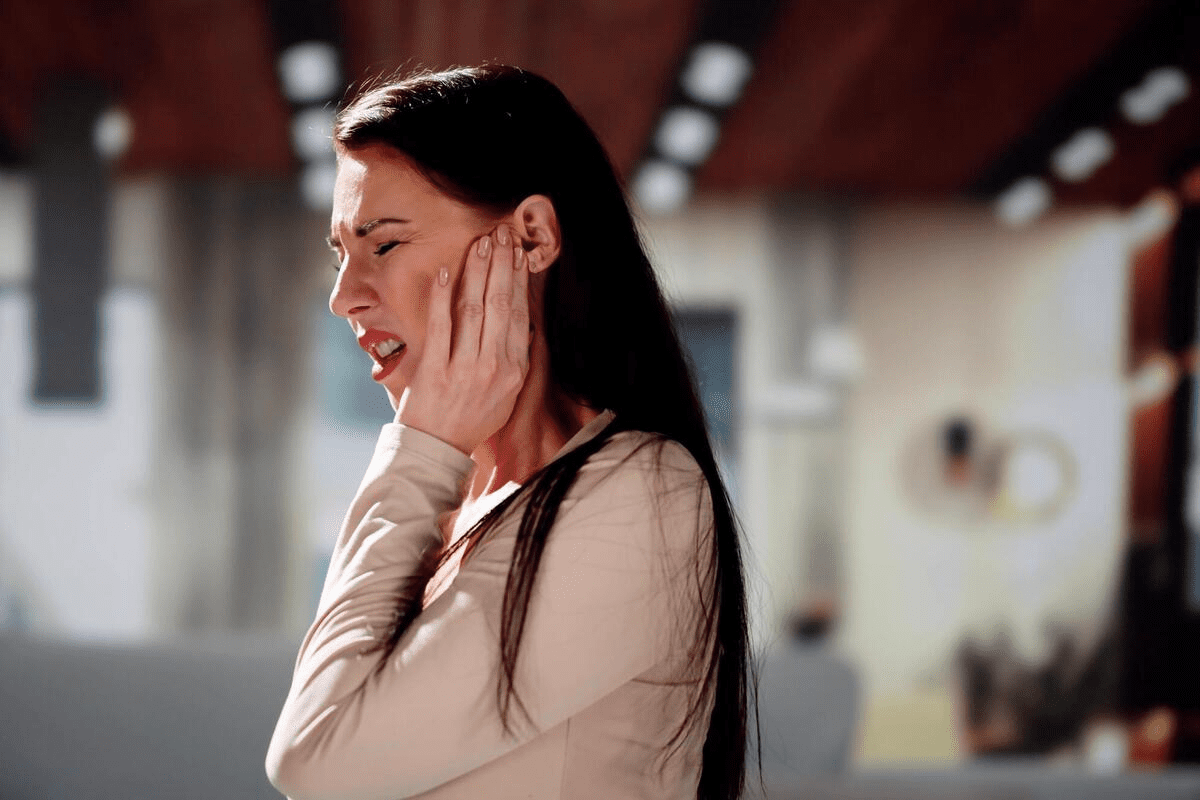Last Updated on November 27, 2025 by Ugurkan Demir

Ear pain after a tonsillectomy can be unexpected and scary. But, it’s a common post-surgical side effect many face during recovery.
Unlike serious complications, ear pain after tonsillectomy happens naturally. It’s because your throat and ears share nerve pathways. This makes it a temporary but manageable part of healing.
At Liv Hospital, we specialize in caring for tonsillectomy patients. We use proven methods and focus on the patient’s needs. This ensures a smooth and comfortable recovery for everyone.
How to ease severe earache post tonsillectomy using pain medication and jaw-stretching exercises.

Ear pain after tonsil removal surgery is common. It can make recovery harder. Knowing why it happens and how to deal with it is key.
Ear pain after tonsillectomy is called otalgia. It happens because of how the throat and ear are connected. This can cause referred pain in the ear after throat surgery.
Many patients get ear pain after tonsillectomy. About 0.4% of patients have ear problems. Factors like age, surgery method, and ear health before surgery can increase this risk.
Risk Factor | Description | Impact on Otalgia |
Age | Patients under 12 years | Higher incidence of otalgia |
Surgical Technique | Use of cautery or laser | Increased risk due to tissue damage |
Pre-existing Ear Conditions | History of ear infections or Eustachian tube dysfunction | Greater likelihood of experiencing otalgia |
It’s important to know the difference between normal and abnormal ear pain. Normal pain is mild and goes away in a few days. But, severe pain, pain that gets worse, or pain with fever or trouble swallowing is not normal.
Understanding these differences helps manage patient expectations and care during recovery.

Earache after a tonsillectomy is common. It happens because of referred pain. This is when pain from one part of the body feels like it’s coming from another.
Referred pain is complex. It happens when nerves from different parts of the body mix together. After a tonsillectomy, pain from the throat can feel like it’s in the ear.
Specific nerves carry pain from the throat to the ear. This is why throat pain can feel like ear pain.
The glossopharyngeal and vagus nerves are key in earache after a tonsillectomy. The glossopharyngeal nerve is important because it connects the throat and ear.
Knowing about these nerves helps us understand ear pain after a tonsillectomy. It shows how throat healing is connected to ear pain.
Throat healing and ear pain are linked through nerves. When the throat heals, pain signals can cause ear discomfort.
Things that affect how bad and long ear pain lasts include:
Understanding these points helps doctors manage ear pain better after a tonsillectomy.
Knowing when ear pain after a tonsillectomy starts and how long it lasts is key. It helps patients manage their recovery better. Ear pain is common after a tonsillectomy, but knowing the timeline can ease worries.
Ear pain usually starts a few days after surgery. Most patients feel ear pain 3 to 7 days after the surgery. This is because of the nerves in the throat and ear causing the pain.
The pain’s intensity can differ from person to person. But, the pain usually peaks in the first week to ten days. During this time, the pain can be worse, mainly when swallowing or yawning.
The length of ear pain after a tonsillectomy varies. But, most people see their pain lessen or go away in 2 weeks. As the throat heals and inflammation goes down, the pain gets better.
Timeline | Ear Pain Characteristics |
0-3 days post-surgery | Minimal to no ear pain |
3-7 days post-surgery | Ear pain begins, gradually increasing |
7-10 days post-surgery | Peak pain period |
10-14 days post-surgery | Ear pain starts to decrease |
After 14 days post-surgery | Significant reduction or complete resolution of ear pain |
Understanding ear pain after a tonsillectomy helps patients prepare for their recovery. While everyone’s experience is different, knowing what to expect can make recovery easier and less stressful.
After a tonsillectomy, pain can be quite a challenge. Knowing about prescription and OTC pain relief is key. It’s important to mix professional advice with home care to manage ear pain well.
Doctors often give pain meds after a tonsillectomy. These include:
These meds are given for a short time to avoid addiction and side effects.
OTC pain relief is also important for ear pain after a tonsillectomy. Common ones are:
Medication | Dosage | Frequency |
Acetaminophen (Tylenol) | 325-650 mg | Every 4-6 hours |
Ibuprofen (Advil, Motrin) | 200-400 mg | Every 4-6 hours |
Always follow the dosage and talk to a doctor before mixing meds.
Topical treatments and throat sprays can help with ear pain from tonsillectomy. They include:
Using these treatments with other pain relief methods can make recovery more comfortable.
Ear pain after a tonsillectomy can be really tough. But, there are home remedies that can help. These self-care strategies can ease ear pain and help you recover.
Temperature therapy is a simple way to ease ear pain. Warm compresses can relax muscles around the ear and throat. This reduces pain and discomfort.
To use a warm compress, soak a cloth in warm water, wring it out, and place it on your ear and cheek. Do this for a few minutes, as often as you need.
On the other hand, some people find relief with cold compresses. Cold can numb pain and reduce swelling. Make sure to wrap the ice pack in a cloth to avoid skin irritation or frostbite.
Drinking plenty of water is key for healing and easing ear pain. It keeps your throat moist and aids in recovery. Aim for 8-10 glasses of water a day, unless your doctor tells you differently.
Changing your diet can also help. Eat soft, bland foods that are easy to swallow. This reduces throat irritation and ear pain. Try to avoid spicy, acidic, or sharp foods during recovery.
Keeping your environment comfortable can help with recovery and ear pain. A humidifier adds moisture to the air, soothing your throat and ears. Dry air can make discomfort worse, so humidifying your space is helpful.
Also, try to avoid irritants like smoke, dust, and strong smells. These can irritate your throat and ears. Make sure your recovery area is quiet and comfortable to help with relaxation and healing.
By using these home remedies, you can manage ear pain after a tonsillectomy. They support your healing process too.
Changing how you sit and use certain physical methods can help lessen ear pain after a tonsillectomy. Try different approaches to see what works best for you.
Choosing the right sleeping position is key to feeling less pain. Try sleeping on your back with a pillow under your knees. This helps ease neck and throat strain.
A medical expert says, “The way you sleep after a tonsillectomy can greatly impact your recovery and level of discomfort.”
“Proper resting positions can alleviate some of the pressure on the throat and surrounding areas, including the ears.”
Head elevation is another good way to lessen ear pain. Use extra pillows or a wedge pillow to lift your head. This helps reduce swelling and aids in healing.
Technique | Description | Benefit |
Extra Pillows | Using additional pillows to elevate the head | Reduces swelling |
Wedge Pillow | A specially designed pillow for head elevation | Promotes healing and reduces discomfort |
Doing gentle jaw and neck exercises can help ease tension and pain in your ears. Simple actions like tilting your head or opening and closing your mouth can help.
Remember to be gentle and avoid any movements that hurt. As you get better, you can slowly do more.
By using these positioning techniques and gentle exercises, you can manage ear pain after a tonsillectomy.
Different age groups have unique needs for managing ear pain after tonsillectomy. The approach to easing this discomfort must be tailored to the individual’s age. This ensures effective relief and minimizes complications.
Children need special care for ear pain after tonsillectomy. Dosage and administration of pain medication must be carefully managed based on the child’s weight and age. It’s also important to keep an eye on their hydration, as they can dehydrate quickly.
Soft, cold foods like ice cream or popsicles can help soothe the throat without causing discomfort. Parents should watch for signs of severe pain or complications, such as difficulty swallowing or breathing. Reassurance and emotional support are vital, as children may become distressed due to their discomfort.
Adults experiencing ear pain after tonsillectomy may have different concerns, such as the impact on their daily activities and work. Pain management strategies for adults may include a combination of prescribed medications and over-the-counter pain relievers. Adults should be encouraged to maintain a soft diet and stay hydrated.
Adults can also benefit from relaxation techniques such as deep breathing or meditation to help manage stress and discomfort. It’s essential for adults to follow post-operative instructions carefully to avoid complications.
Elderly patients may face unique challenges when recovering from tonsillectomy, including managing ear pain. Careful monitoring of medication is necessary to avoid interactions with other medications they may be taking. Elderly patients should be closely monitored for signs of dehydration and possible complications.
It’s also important to consider any pre-existing conditions that may affect their recovery, such as heart disease or diabetes. Support from caregivers can be invaluable in helping elderly patients manage their recovery and alleviate ear pain.
It’s important to know when ear pain after a tonsillectomy means you need to see a doctor right away. Some pain is normal, but other signs can mean serious problems.
Keep an eye on your symptoms after a tonsillectomy. Warning signs of complications include:
If you notice any of these, call your doctor fast.
Ear pain after a tonsillectomy can sometimes be severe and persistent. If your pain doesn’t get better with medicine, or if you have side effects, tell your doctor.
Some situations are emergencies. These emergency situations include:
In emergencies, don’t wait. Go to the emergency room or call emergency services.
Knowing the warning signs and when to get help can greatly improve your recovery after a tonsillectomy.
Managing ear pain after a tonsillectomy requires a mix of medical treatments and home remedies. We’ve covered the causes, how long it lasts, and ways to ease the pain. This gives you a full guide to handle this common issue after surgery.
Knowing about referred pain and the nerves involved helps in recovery. We suggest using medicines, home treatments like temperature therapy and staying hydrated. Also, try sleeping right and doing gentle jaw exercises.
It’s key to manage ear pain well for a smooth recovery. Be on the lookout for signs of complications and reach out to your doctor if needed. Being proactive and informed can reduce discomfort and help you heal faster.
In summary, dealing with ear pain after a tonsillectomy is doable with the right steps. We urge patients to team up with their healthcare team. Together, you can create a plan to manage pain and get through the recovery smoothly.
Post-tonsillectomy otalgia is ear pain after having your tonsils removed. It’s a common issue. The pain often comes from the throat and goes to the ear.
Ear pain after a tonsillectomy can last a while. It usually starts a few days after surgery. It gets worse around 3-5 days and can last up to two weeks.
The main cause of ear pain after a tonsillectomy is referred pain. This pain comes from the throat and travels to the ear through nerves.
To manage ear pain, try prescription and over-the-counter pain meds. Home remedies like temperature therapy and staying hydrated help too. Also, try sleeping right and doing gentle exercises.
For a severe earache, try temperature therapy and stay hydrated. Using a humidifier and making your environment comfortable also helps.
Call your doctor if the pain is too much and doesn’t get better. Also, if you see warning signs of complications or have an emergency like trouble breathing or a lot of bleeding.
Yes, managing ear pain after a tonsillectomy depends on your age. There are special tips for kids, adults, and the elderly.
Yes, you can use over-the-counter pain meds for ear pain. But, always follow the dosage and talk to your doctor if you need to.
To reduce ear pain while sleeping, try sleeping with your head up and on your side. This can help.
Yes, doing gentle jaw and neck exercises can help. They promote healing and reduce tension in the area.
Subscribe to our e-newsletter to stay informed about the latest innovations in the world of health and exclusive offers!